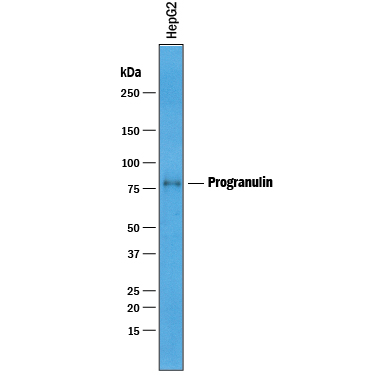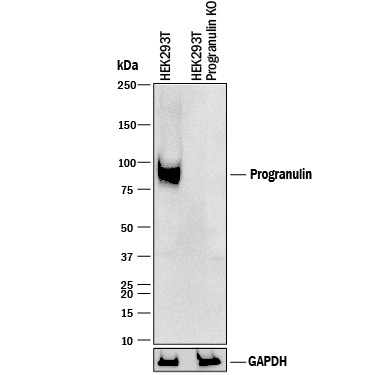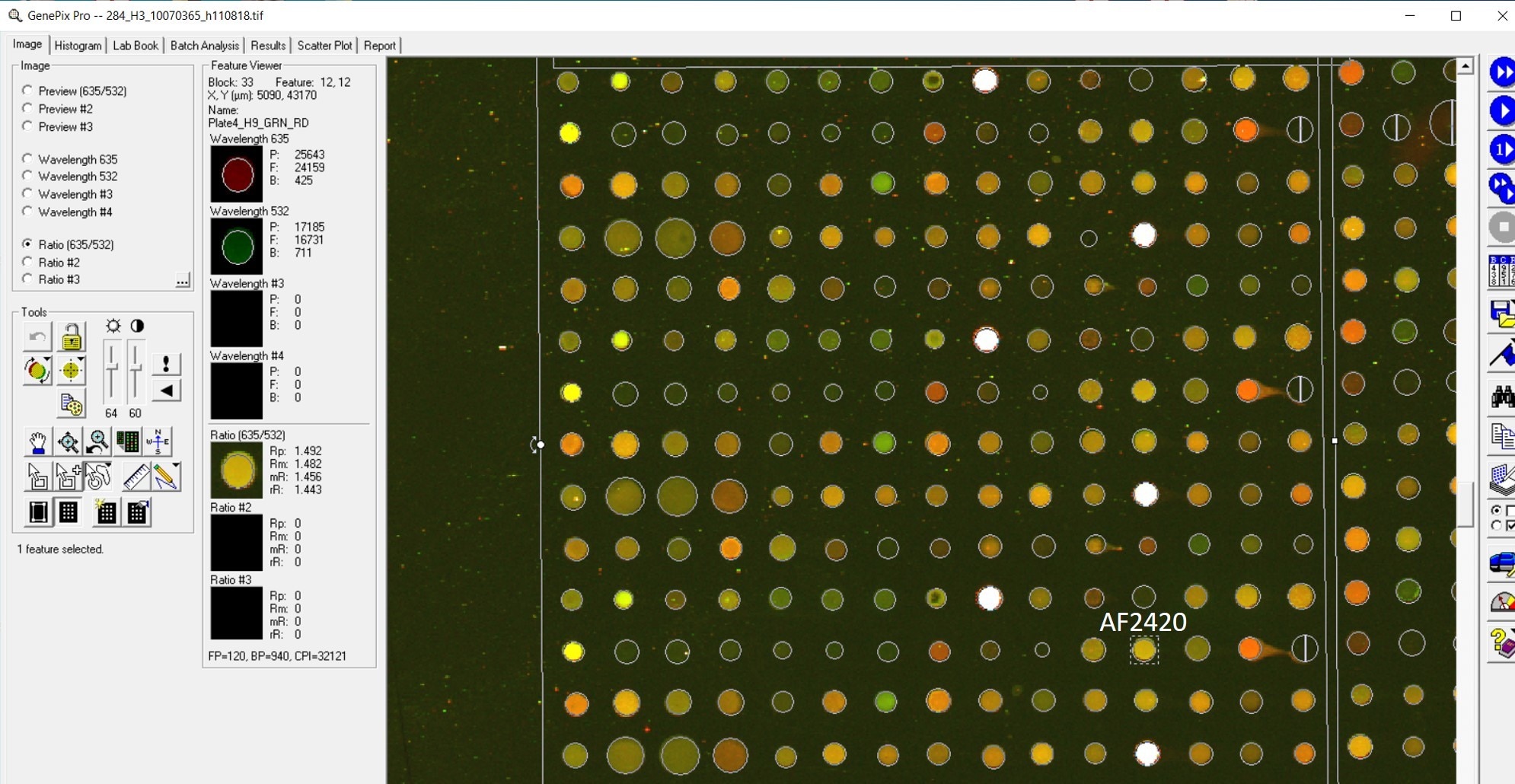Human Progranulin/PGRN Antibody Summary
Thr18-Leu593
Accession # P28799
Applications
Please Note: Optimal dilutions should be determined by each laboratory for each application. General Protocols are available in the Technical Information section on our website.
Scientific Data
 View Larger
View Larger
Detection of Human Progranulin/PGRN by Western Blot. Western blot shows lysates of HepG2 human hepatocellular carcinoma cell line. PVDF membrane was probed with 1 µg/mL of Goat Anti-Human Progranulin/PGRN Antigen Affinity-purified Polyclonal Antibody (Catalog # AF2420) followed by HRP-conjugated Anti-Goat IgG Secondary Antibody (HAF019). A specific band was detected for Progranulin/PGRN at approximately 80 kDa (as indicated). This experiment was conducted under reducing conditions and using Immunoblot Buffer Group 1.
 View Larger
View Larger
Progranulin in Human Breast Cancer Tissue. Progranulin was detected in paraffin-embedded sections of human breast cancer tissue using Goat Anti-Human Progranulin Antigen Affinity-purified Polyclonal Antibody (Catalog # AF2420) at 1.7 µg/mL overnight at 4 °C. Tissue was stained using the Anti-Goat HRP-DAB Cell & Tissue Staining Kit (brown; CTS008) and counterstained with hematoxylin (blue). View our protocol for Chromogenic IHC Staining of Paraffin-embedded Tissue Sections.
 View Larger
View Larger
Western Blot Shows Human Progranulin/PGRN Specificity by Using Knockout Cell Line. Western blot shows lysates of HEK293T human embryonic kidney parental cell line and Progranulin knockout HEK293T cell line (KO). PVDF membrane was probed with 1 µg/mL of Goat Anti-Human Progranulin/PGRN Antigen Affinity-purified Polyclonal Antibody (Catalog # AF2420) followed by HRP-conjugated Anti-Goat IgG Secondary Antibody (HAF017). A specific band was detected for Progranulin/PGRN at approximately 80 kDa (as indicated) in the parental HEK293T cell line, but is not detectable in knockout HEK293T cell line. GAPDH (AF5718) is shown as a loading control. This experiment was conducted under reducing conditions and using Immunoblot Buffer Group 1.
Reconstitution Calculator
Preparation and Storage
- 12 months from date of receipt, -20 to -70 °C as supplied.
- 1 month, 2 to 8 °C under sterile conditions after reconstitution.
- 6 months, -20 to -70 °C under sterile conditions after reconstitution.
Background: Progranulin/PGRN
Progranulin, also known as acrogranin, PC cell-derived growth factor (PCDGF) and epithelin/granulin precursor, is a ubiquitously expressed, 88 kDa, secreted glycoprotein (1‑3). Structurally, it does not belong to any of the well-established growth factor families (4). Human Progranulin is 593 amino acids (aa) in length and contains a 17 aa signal sequence and 5 potential sites for N-linked glycosylation (Swiss Prot # P28799). It has a highly repetitive organization, containing seven tandem copies of a 55-57 aa consensus motif that contains 12 conserved cysteine residues: VXCX5-6CX5CCX8CCX6CCXDX2HCCPX4CX5-6CX2 (1). There is one alternate splice form for human Progranulin. This has a deletion of aa corresponding to aa 377-531 of the standard form. Progranulin is secreted as a full length form (2, 4), and may undergo proteolysis leading to the release of numerous peptides made from the seven tandem repeats, called the granulins (5-7). Human Progranulin shares 75% aa sequence identity with mouse and rat Progranulin. Progranulin is involved in the regulation of cellular proliferation, as well as differentiation, development, and pathological processes (4). It has been isolated as a differentially expressed gene during mesothelial differentiation (8), macrophage development (9), the development of rheumatoid arthritis and osteoarthritis (10), sexual differentiation of the brain (11), and has also been shown to be a mediator of cartilage proliferation and of wound response and tissue repair (4, 12 13). High levels of Progranulin expression have been found to be associated with several human cancers and are believed to contribute to tumorigenesis in breast cancer, clear cell renal carcinoma, invasive ovarian carcinoma, glioblastoma, adipocyte teratoma, and multiple myeloma (4-5, 12, 14-19). In addition, mutations in the Progranulin gene are a cause of frontotemporal dementia, and increased expression of Progranulin is seen in activated microglia in many neurodegenerative diseases including Creutzfeldt-Jakob disease, motor neuron disease and Alzheimer's disease (20). Mutations in Progranulin causing neurodegenerative disease indicate that Progranulin is important for neuronal survival (20).
- Plowman, G.D. et al. (1992) J. Biol. Chem. 267:13073.
- Zhou, J. et al. (1993) J. Biol. Chem. 268:10863.
- Liu, Y. et al. (2007) BMC Cancer 7:22.
- Xu, K. et al. (2007) J. Biol. Chem. 282:11347.
- Davidson, B. et al. (2004) Cancer 100:2139.
- Zanocco-Marani, T. et al. (1999) Cancer Res. 59:5331.
- Lu, R. and G. Serrero (2000) Proc. Natl. Acad. Sci. USA 97:3993.
- Sun, X. et al. (2004) Am. J. Respir. Cell Mol. Biol. 30:510.
- Barreda, D.R. et al. (2004) Dev. Comp. Immunol. 28:727.
- Justen, H.P. et al. (2000) Mol. Cell Biol. Res. Commun. 3:165.
- Suzuki, M. and M. Nishiahara (2002) Mol. Genet. Metab. 75:31.
- He, Z. et al. (2003) Nat. Med. 9:225.
- Zhu, J. et al. (2002) Cell 111:867.
- He, Z. and A. Bateman (2003) J. Mol. Med. 81:600.
- Bateman, A. et al. (1990) Biochem. Biophys. Res. Commun. 173:1161.
- Gonzalez, E.M. et al. (2003) J. Biol. Chem. 278:38113.
- Jones, M.B. et al. (2003) Gynecol. Oncol. 88:S136.
- Wang, W. et al. (2003) Clin. Cancer Res. 9:2221.
- Zhang, H. and G. Serrero (1998) Proc. Natl. Acad. Sci. USA 95:14202.
- Baker, M. et al. (2006) Nature 442:916.
Product Datasheets
Citations for Human Progranulin/PGRN Antibody
R&D Systems personnel manually curate a database that contains references using R&D Systems products. The data collected includes not only links to publications in PubMed, but also provides information about sample types, species, and experimental conditions.
22
Citations: Showing 1 - 10
Filter your results:
Filter by:
-
Progranulin AAV gene therapy for frontotemporal dementia: translational studies and phase 1/2 trial interim results
Authors: Sevigny, J;Uspenskaya, O;Heckman, LD;Wong, LC;Hatch, DA;Tewari, A;Vandenberghe, R;Irwin, DJ;Saracino, D;Le Ber, I;Ahmed, R;Rohrer, JD;Boxer, AL;Boland, S;Sheehan, P;Brandes, A;Burstein, SR;Shykind, BM;Kamalakaran, S;Daniels, CW;David Litwack, E;Mahoney, E;Velaga, J;McNamara, I;Sondergaard, P;Sajjad, SA;Kobayashi, YM;Abeliovich, A;Hefti, F;
Nature medicine
Species: Mouse
Sample Types: Tissue Homogenates
Applications: ELISA Capture -
Reduced progranulin increases tau and ?-synuclein inclusions and alters mouse tauopathy phenotypes via glucocerebrosidase
Authors: Takahashi, H;Bhagwagar, S;Nies, SH;Ye, H;Han, X;Chiasseu, MT;Wang, G;Mackenzie, IR;Strittmatter, SM;
Nature communications
Species: Murine polyomavirus strain A3
Sample Types: Whole Tissue
Applications: Immunohistochemistry -
Progranulin haploinsufficiency mediates cytoplasmic TDP-43 aggregation with lysosomal abnormalities in human microglia
Authors: Sung, W;Noh, MY;Nahm, M;Kim, YS;Ki, CS;Kim, YE;Kim, HJ;Kim, SH;
Journal of neuroinflammation
Species: Human
Sample Types: Protein, Whole Cells
Applications: Western Blot, Immunocytochemistry -
AAV-GRN partially corrects motor deficits and ALS/FTLD-related pathology in Tmem106bGrn mice
Authors: Feng T, Minevich G, Liu P et al.
iScience
-
Pathological 25 kDa C-Terminal Fragments of TDP-43 Are Present in Lymphoblastoid Cell Lines and Extracellular Vesicles from Patients Affected by Frontotemporal Lobar Degeneration and Neuronal Ceroidolipofuscinosis Carrying a GRN Mutation
Authors: S Cimini, S Bellini, C Saraceno, L Benussi, R Ghidoni, SC Giliani, G Puoti, L Canafoglia, G Giaccone, G Rossi
International Journal of Molecular Sciences, 2022-11-09;23(22):.
Species: Human
Sample Types: Cell Lysates
Applications: Western Blot -
Deficiency of the frontotemporal dementia gene GRN results in gangliosidosis
Authors: S Boland, S Swarup, YA Ambaw, PC Malia, RC Richards, AW Fischer, S Singh, G Aggarwal, S Spina, AL Nana, LT Grinberg, WW Seeley, MA Surma, C Klose, JA Paulo, AD Nguyen, JW Harper, TC Walther, RV Farese
Nature Communications, 2022-10-07;13(1):5924.
Species: Human
Sample Types: Cell Lysates
Applications: Western Blot -
Regulated control of gene therapies by drug-induced splicing
Authors: AM Monteys, AA Hundley, PT Ranum, L Tecedor, A Muehlmatt, E Lim, D Lukashev, R Sivasankar, BL Davidson
Nature, 2021-07-28;0(0):.
Species: Mouse
Sample Types: Tissue Homogenates
Applications: FRET -
Delivering progranulin to neuronal lysosomes protects against excitotoxicity
Authors: SE Davis, JR Roth, Q Aljabi, AR Hakim, KE Savell, JJ Day, AE Arrant
The Journal of Biological Chemistry, 2021-07-21;0(0):100993.
Species: Human
Sample Types: Cell Lysates, Whole Cells
Applications: IHC, Western Blot -
Neuropathological and behavioral characterization of aged Grn R493X progranulin-deficient frontotemporal dementia knockin mice
Authors: J Frew, HB Nygaard
Acta neuropathologica communications, 2021-04-01;9(1):57.
Species: Mouse
Sample Types: Tissue Homogenates, Whole Tissue
Applications: IHC, Western Blot -
Tumor co-expression of progranulin and sortilin as a prognostic biomarker in breast cancer
Authors: K Berger, S Rhost, S Rafnsdótti, É Hughes, Y Magnusson, M Ekholm, O Stål, L Rydén, G Landberg
BMC Cancer, 2021-02-22;21(1):185.
Species: Human
Sample Types: Whole Tissue
Applications: IHC -
Premature termination codon readthrough upregulates progranulin expression and improves lysosomal function in preclinical models of GRN deficiency
Authors: J Frew, A Baradaran-, AD Balgi, X Wu, TD Yan, S Arns, FS Shidmoossa, J Tan, JB Jaquith, KR Jansen-Wes, FC Lynn, FB Gao, L Petrucelli, HH Feldman, IR Mackenzie, M Roberge, HB Nygaard
Mol Neurodegener, 2020-03-16;15(1):21.
Species: Human
Sample Types: Whole Cells
Applications: ICC -
Characterization of lysosomal proteins Progranulin and Prosaposin and their interactions in Alzheimer's disease and aged brains: increased levels correlate with neuropathology
Authors: A Mendsaikha, I Tooyama, JP Bellier, GE Serrano, LI Sue, LF Lue, TG Beach, DG Walker
Acta Neuropathol Commun, 2019-12-21;7(1):215.
Species: Human
Sample Types: Protein, Tissue Homogenates, Whole Tissue
Applications: IHC-Fr, Immunoprecipitation, Western Blot -
Loss of Tmem106b is unable to ameliorate frontotemporal dementia-like phenotypes in an AAV mouse model of C9ORF72-repeat induced toxicity
Authors: AM Nicholson, X Zhou, RB Perkerson, TM Parsons, J Chew, M Brooks, M DeJesus-He, NA Finch, BJ Matchett, A Kurti, KR Jansen-Wes, E Perkerson, L Daughrity, M Castanedes, L Rousseau, V Phillips, F Hu, TF Gendron, ME Murray, DW Dickson, JD Fryer, L Petrucelli, R Rademakers
Acta Neuropathol Commun, 2018-05-31;6(1):42.
Species: Human
Sample Types: Cell Lysates
Applications: Western Blot -
Lysosomal processing of progranulin
Authors: X Zhou, DH Paushter, T Feng, L Sun, T Reinheckel, F Hu
Mol Neurodegener, 2017-08-23;12(1):62.
Species: Human
Sample Types: Cell Lysates
Applications: Western Blot -
The lysosomal protein cathepsin L is a progranulin protease
Authors: CW Lee, JN Stankowski, J Chew, CN Cook, YW Lam, S Almeida, Y Carlomagno, KF Lau, M Prudencio, FB Gao, M Bogyo, DW Dickson, L Petrucelli
Mol Neurodegener, 2017-07-25;12(1):55.
Species: Human
Sample Types: Cell Lysates, Whole Cells, Whole Tissue
Applications: ICC, IHC, Western Blot -
Oxidoreductase activity is necessary for N-glycosylation of cysteine-proximal acceptor sites in glycoproteins.
Authors: Cherepanova N, Shrimal S, Gilmore R
J Cell Biol, 2014-08-18;206(4):525-39.
Species: Human
Sample Types: Cell Lysates
Applications: Western Blot -
Evidence of the innate antiviral and neuroprotective properties of progranulin.
Authors: Suh H, Lo Y, Choi N, Letendre S, Lee S
PLoS ONE, 2014-05-30;9(5):e98184.
Species: Human
Sample Types: Cell Lysates
Applications: Western Blot -
Regulation of progranulin expression in human microglia and proteolysis of progranulin by matrix metalloproteinase-12 (MMP-12).
Authors: Suh HS, Choi N, Tarassishin L, Lee SC
PLoS ONE, 2012-04-11;7(4):e35115.
Species: Human
Sample Types: Cell Lysates
Applications: Western Blot -
Progranulin modulates zebrafish motoneuron development in vivo and rescues truncation defects associated with knockdown of Survival motor neuron 1.
Authors: Chitramuthu BP, Baranowski DC, Kay DG
Mol Neurodegener, 2010-10-14;5(0):41.
Species: Human
Sample Types: Tissue Homogenates
Applications: Western Blot -
Pathogenic cysteine mutations affect progranulin function and production of mature granulins.
Authors: Wang J, Van Damme P, Cruchaga C, Gitcho MA, Vidal JM, Seijo-Martinez M, Wang L, Wu JY, Robberecht W, Goate A
J. Neurochem., 2009-12-17;112(5):1305-15.
Species: Human
Sample Types: Cell Lysates
Applications: Western Blot -
Progranulin expression correlates with dense-core amyloid plaque burden in Alzheimer disease mouse models.
Authors: Pereson S, Wils H, Kleinberger G, McGowan E, Vandewoestyne M, Van Broeck B, Joris G, Cuijt I, Deforce D, Hutton M, Van Broeckhoven C, Kumar-Singh S
J. Pathol., 2009-10-01;219(2):173-81.
Species: Human
Sample Types: Whole Tissue
Applications: IHC-P -
HDDD2 is a familial frontotemporal lobar degeneration with ubiquitin-positive, tau-negative inclusions caused by a missense mutation in the signal peptide of progranulin.
Authors: Mukherjee O, Pastor P, Cairns NJ, Chakraverty S, Kauwe JS, Shears S, Behrens MI, Budde J, Hinrichs AL, Norton J, Levitch D, Taylor-Reinwald L, Gitcho M, Tu PH, Tenenholz Grinberg L, Liscic RM, Armendariz J, Morris JC, Goate AM
Ann. Neurol., 2006-09-01;60(3):314-22.
Species: Human
Sample Types: Whole Tissue
Applications: IHC
FAQs
No product specific FAQs exist for this product, however you may
View all Antibody FAQsReviews for Human Progranulin/PGRN Antibody
Average Rating: 4 (Based on 3 Reviews)
Have you used Human Progranulin/PGRN Antibody?
Submit a review and receive an Amazon gift card.
$25/€18/£15/$25CAN/¥75 Yuan/¥2500 Yen for a review with an image
$10/€7/£6/$10 CAD/¥70 Yuan/¥1110 Yen for a review without an image
Filter by:


